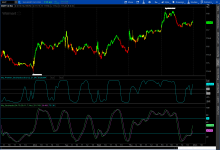any help getting pso... its calculated as below.
%K = 100 X [(C – Ln) / (Hn – Ln)]
Where
The premier stochastic oscillator normalizes the standard stochastic oscillator by applying a five-period double exponential smoothing average of the %K value, resulting in a symmetric scale of 1 to -1. The PSO calculation, then, is:
PSO = (exponential value (S) – 1) / (exponential value (S) + 1)
Where
%K = 100 X [(C – Ln) / (Hn – Ln)]
Where
- C = the most recent closing price
- n = the lookback period
- Ln = the low of the n previous price bars
- Hn = the highest price during the same n period
The premier stochastic oscillator normalizes the standard stochastic oscillator by applying a five-period double exponential smoothing average of the %K value, resulting in a symmetric scale of 1 to -1. The PSO calculation, then, is:
PSO = (exponential value (S) – 1) / (exponential value (S) + 1)
Where
- S = 5-period double smoothed exponential EMA ((%K – 50) * .1)
- %K = 8-period stochastic oscillator

